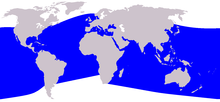Common bottlenose dolphin: Difference between revisions
start stub |
start expansion |
||
| Line 21: | Line 21: | ||
}} |
}} |
||
The '''Common Bottlenose Dolphin''' (''Tursiops truncatus'') is a species of bottlenose dolphin. |
The '''Common Bottlenose Dolphin''' (''Tursiops truncatus'') is a species of [[bottlenose dolphin]]. The Common Bottlenose Dolphin inhabits [[warm]] and [[temperate]] seas worldwide. |
||
The Common Bottlenose Dolphin is grey in color and can be between {{convert|2|and|4|m|ft|lk=on}} long, and weigh between {{convert|150|and|650|kg|lb|lk=on}}. Its most distinguishing feature is the elongated snout, the [[rostrum (anatomy)|rostrum]], which gives the animal its common name. Like all whales and dolphins, though, the snout is not the functional nose; rather, the functional nose is the [[blowhole (bio)|blowhole]] on the top of its head. |
|||
The Common Bottlenose Dolphin lives in groups called pods that typically number about 15 dolphins, but group size varies from solitary bottlenose dolphins up to groups of over 100 or even occasionally over 1000 animals. Its diet consists mainly of small fish. Dolphin groups often work as a team to harvest schools of fish, but they also hunt individually. Dolphins search for prey primarily using [[echolocation]], which is similar to sonar. They emit clicking sounds and listen for the return echo to determine the location and shape of nearby items, including potential prey. The Common Bottlenose Dolphin also uses sound for communication. Sounds used for communication include squeaks and whistles emitted from the blowhole and sounds emitted through body language, such as leaping from the water and slapping their tails on the water. |
|||
There have been numerous investigations of Common Bottlenose Dolphin intelligence. Such testing has included tests of mimicry, use of artificial language, object categorization and self-recognition. This intelligence has driven considerable interaction with humans. The Common Bottlenose Dolphin is popular from aquarium shows and television programs such as ''[[Flipper (1964 TV series)|Flipper]]''. It has also been trained by militaries for tasks such as locating sea mines or detecting and marking enemy divers. In some areas they cooperate with local fishermen by driving fish towards the fishermen and eating the fish that escape the fishermen's nets. Some interactions with humans are harmful to the dolphins: people hunt Bottlenose Dolphins for food, and dolphins are killed inadvertently as a [[cetacean bycatch|bycatch]] of tuna fishing. |
|||
==References== |
==References== |
||
Revision as of 05:08, 18 January 2009
| Bottlenose Dolphin[1] | |
|---|---|

| |
| Bottlenose Dolphin breaching in the bow wave of a boat | |

| |
| Size comparison against an average human | |
| Scientific classification | |
| Kingdom: | |
| Phylum: | |
| Class: | |
| Order: | |
| Family: | |
| Genus: | Tursiops
|
| Species: | T. truncatus
|
| Binomial name | |
| Tursiops truncatus Montagu, 1821
| |

| |
| Bottlenose Dolphin range (in blue) | |
The Common Bottlenose Dolphin (Tursiops truncatus) is a species of bottlenose dolphin. The Common Bottlenose Dolphin inhabits warm and temperate seas worldwide.
The Common Bottlenose Dolphin is grey in color and can be between 2 and 4 metres (6.6 and 13.1 ft) long, and weigh between 150 and 650 kilograms (330 and 1,430 lb). Its most distinguishing feature is the elongated snout, the rostrum, which gives the animal its common name. Like all whales and dolphins, though, the snout is not the functional nose; rather, the functional nose is the blowhole on the top of its head.
The Common Bottlenose Dolphin lives in groups called pods that typically number about 15 dolphins, but group size varies from solitary bottlenose dolphins up to groups of over 100 or even occasionally over 1000 animals. Its diet consists mainly of small fish. Dolphin groups often work as a team to harvest schools of fish, but they also hunt individually. Dolphins search for prey primarily using echolocation, which is similar to sonar. They emit clicking sounds and listen for the return echo to determine the location and shape of nearby items, including potential prey. The Common Bottlenose Dolphin also uses sound for communication. Sounds used for communication include squeaks and whistles emitted from the blowhole and sounds emitted through body language, such as leaping from the water and slapping their tails on the water.
There have been numerous investigations of Common Bottlenose Dolphin intelligence. Such testing has included tests of mimicry, use of artificial language, object categorization and self-recognition. This intelligence has driven considerable interaction with humans. The Common Bottlenose Dolphin is popular from aquarium shows and television programs such as Flipper. It has also been trained by militaries for tasks such as locating sea mines or detecting and marking enemy divers. In some areas they cooperate with local fishermen by driving fish towards the fishermen and eating the fish that escape the fishermen's nets. Some interactions with humans are harmful to the dolphins: people hunt Bottlenose Dolphins for food, and dolphins are killed inadvertently as a bycatch of tuna fishing.
References
- ^ Mead, J. G.; Brownell, R. L. Jr. (2005). "Order Cetacea". In Wilson, D. E.; Reeder, D. M. (eds.). Mammal Species of the World: A Taxonomic and Geographic Reference (3rd ed.). Johns Hopkins University Press. pp. 723–743. ISBN 978-0-8018-8221-0. OCLC 62265494.
- ^ Template:IUCN2008

